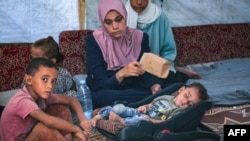We live in a time of “enormous humanitarian need,” yet, with only 30 percent of the funding met, the humanitarian system is significantly under-resourced, said Secretary of State Antony Blinken.
“This era of severe and protracted crises requires us to fundamentally reevaluate our current humanitarian system and its capacity to help those whose needs are the greatest,” he said.
“This conversation simply has to start by including a broad range of voices: government officials, civil society, multilateral development banks, philanthropy, the private sector, humanitarian organizations – and maybe most crucially, the people affected by these crises.”
Secretary Blinken offered three suggestions on how to adapt the humanitarian system to be more effective.
“First, we have to strengthen the link between humanitarian and development efforts,” he said.
“We know these streams of work proceed in parallel. But … when the humanitarians and the development experts work and plan together – especially from the onset of a crisis, we can assist more people with the same resources.”
“An integrated approach also tends to produce longer-term solutions that move people toward sustainable livelihoods,” he added.
“Second, we need to deepen support for host countries as they work to integrate displaced people.”
“It takes years, sometimes generations, for people who are fleeing conflict and persecution to actually be able to safely return to their countries and communities of origin,” he said. “That’s why we need to accelerate efforts to move from a model that relies on emergency social services to one that helps host governments incorporate displaced persons into national health, education systems, economies – permitting them to fully participate in society; and one that helps the host communities benefit from stronger, better-resourced services and support.”
“Finally, we have to find ways to deepen cooperation with the private sector.”
“Together, we can pursue blended finance strategies to lower the risks for investment in fragile markets, and attract much needed capital – expanding opportunity, reducing the need for aid,” he said. “The private sector can also help us engage innovative technologies – like AI-powered predictive capabilities that forecast the displacement of people after natural disasters, that identify the host communities where refugees are most likely to succeed.”
“Readapting this global humanitarian architecture is not just a strategic necessity,” said Secretary Blinken. “It’s a moral imperative – for the people we aim to assist, and for the humanitarian workers who are serving with such incredible courage on the front lines every day.”














